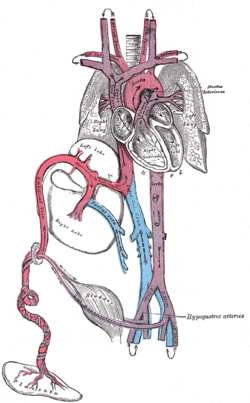Ductus arteriosus
| Ductus arteriosus | |
|---|---|

Plan of the fetal circulation. ("Ductus arteriosus" visible at upper right.)
|
|

Heart cross-section with PDA
|
|
| Details | |
| Precursor | aortic arch 6 |
| Source | pulmonary artery |
| Branches | descending aorta |
| Vein | ductus venosus |
| Identifiers | |
| Latin | Ductus arteriosus |
| MeSH | A07.541.278.395 |
| TE | E5.11.2.1.2.0.17 |
| FMA | 79871 |
|
Anatomical terminology []
|
|
In the developing fetus, the ductus arteriosus, also called the ductus Botalli, is a blood vessel connecting the pulmonary artery to the proximal descending aorta. It allows most of the blood from the right ventricle to bypass the fetus's fluid-filled non-functioning lungs. Upon closure at birth, it becomes the ligamentum arteriosum. There are two other fetal shunts, the ductus venosus and the foramen ovale.
The ductus arteriosus is formed from the left 6th aortic arch during embryonic development and attaches to the final part of the arch of aorta (the isthmus of aorta) and the first part of the pulmonary artery
Failure of the DA to close after birth results in a condition called patent ductus arteriosus and the generation of a left-to-right shunt. If left uncorrected, patency leads to pulmonary hypertension and possibly congestive heart failure and cardiac arrhythmias.
The E series of prostaglandins are responsible for maintaining the patency of the DA (by dilation of vascular smooth muscle) throughout the fetal period. Prostaglandin E2 (PGE2), produced by both the placenta and the DA itself, is the most potent of the E prostaglandins, but prostaglandin E1 (PGE1) also has a role in keeping the DA open. PGE1 and PGE2 keep the DA open via involvement of specific PGE-sensitive receptors (such as EP4 and EP2). EP4 is the major receptor associated with PGE2-induced dilation of the DA and can be found across the DA in smooth muscle cells. Immediately after birth, the levels of both PGE2 and the EP4 receptors reduce significantly, allowing for closure of the DA and establishment of normal postnatal circulation.
...
Wikipedia
